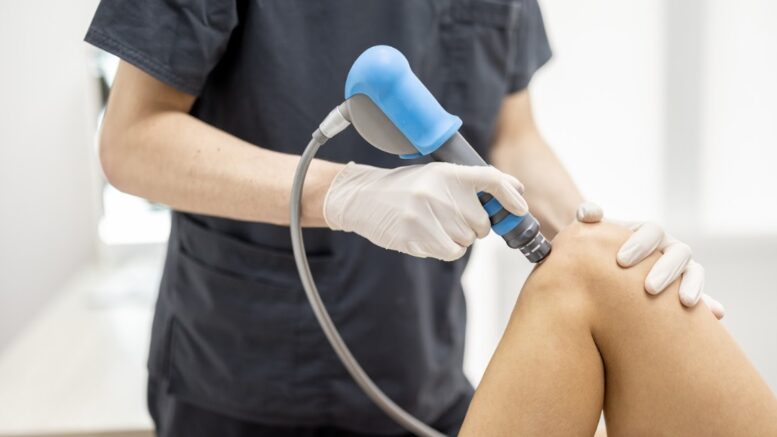Joint pain is a prevalent condition that affects millions of people worldwide, influencing their daily lives and activities. As medical science has evolved, numerous treatment modalities have emerged, each with its own advantages and considerations.
Among the plethora of available treatments, electrical stimulation stands out as a modern approach that contrasts with the tried-and-true traditional therapies. This article aims to delve deep into the intricacies of both, laying out their mechanisms, advantages, drawbacks, and more.
Electrical Stimulation
Electrical stimulation has garnered attention in recent years, particularly as an innovative approach to knee pain therapy. By harnessing the power of electricity, it aims to alter pain perception and enhance joint and muscle functionality.
Electrical stimulation employs devices that send electrical impulses through the skin to underlying nerves. By targeting specific nerve pathways, these devices can effectively disrupt or modify pain signals being sent to the brain. Furthermore, certain forms of electrical stimulation can encourage muscle contraction, aiding in muscle strength and potentially promoting recovery.
There are different types of electrical stimulation devices, with Transcutaneous Electrical Nerve Stimulation (TENS) and Neuromuscular Electrical Stimulation (NMES) being the most common. While TENS predominantly targets pain modulation, NMES focuses on muscle functionality
As the popularity and application of these devices grow, it’s essential to understand the following potential benefits and limitations:
Advantages
- Non-Invasiveness: Electrical stimulation is a non-invasive method. This means it doesn’t require any incisions or penetration into the body, reducing potential complications.
- Personalization: Users can typically adjust the intensity and frequency of the electrical impulses, ensuring a tailored experience that caters to individual pain thresholds and preferences.
- Portability: Modern devices are compact and can be worn discreetly, allowing users to benefit from treatment even while on the move.
- Immediate Results: Many users report instant relief upon using the device, making it a preferred choice for those seeking immediate alleviation.
Drawbacks
- Not Universally Effective: Like all medical treatments, electrical stimulation doesn’t work for everyone. Some individuals may find little to no relief.
- Potential Overuse: Using the device too frequently or at very high intensities can lead to muscle soreness or skin irritation.
- Usage Restrictions: It’s imperative to avoid placing electrodes near sensitive areas like the front of the neck or over broken skin. Furthermore, individuals with certain medical devices, such as pacemakers, should exercise caution or avoid using these devices altogether.
Electrical stimulation represents the convergence of technology and medical science, offering a non-invasive and adaptable solution to pain management. As the landscape of healthcare evolves, it remains a beacon of modernity, providing many with immediate relief and a sense of autonomy over their pain.
Traditional Joint Pain Therapies
Traditional joint pain therapies encompass a broad spectrum of treatments, each backed by years, if not centuries, of application and results.
The mechanism through which traditional therapies function varies considerably, from reducing inflammation to repairing damaged joint tissue. Some aim to provide immediate relief, while others focus on long-term recovery and pain management.

Physical therapy is one such intervention that emphasizes improving joint mobility and strength. In contrast, medications such as NSAIDs tackle inflammation, and surgical interventions can correct anatomical issues causing pain.
With each method offering distinct benefits and challenges, it’s time to delve deeper into the advantages and drawbacks of traditional joint pain therapies.
Advantages
- Time-Tested: Many traditional therapies have stood the test of time, with years of successful applications that validate their efficacy.
- Comprehensive Treatment Options: The vast range of traditional therapies ensures there’s something for everyone, regardless of the pain’s source or severity.
- Targeted Approach: Interventions like joint injections directly address the root cause of pain, delivering the active ingredient right to the source.
- Potential For Long-Term Relief: Surgical interventions, while invasive, can sometimes provide permanent solutions to persistent pain issues.
Drawbacks
- Side Effects: Medications, particularly when used long-term, come with potential side effects that can affect other bodily systems.
- Invasiveness And Risk: Surgical interventions involve inherent risks such as infections or complications. Recovery periods can be long and, at times, painful.
- Accessibility: Some treatments may not be readily available to everyone due to costs or the need for specialized medical professionals.
Traditional joint pain therapies are pillars of the medical community, grounded in years of trust and successful outcomes. Their diverse range and deep-rooted history offer a testament to their effectiveness, and they continue to serve as a refuge for many in their quest for pain alleviation.
Making An Informed Decision
Choosing between electrical stimulation and traditional joint pain therapies is not a simple task. Both avenues offer unique benefits, and the best choice often hinges on the individual’s specific condition, personal preferences, and treatment goals.
Effectiveness, safety, accessibility, and duration of relief vary between the two. For instance, while electrical stimulation provides immediate but sometimes temporary relief, surgical interventions under the traditional therapies umbrella can offer more lasting solutions.
Furthermore, it’s essential to note that many patients find the most significant relief by combining various treatments. A comprehensive pain management plan might incorporate both electrical stimulation and traditional therapies, drawing on the strengths of each to provide holistic care.
The Takeaway
As the medical community continues to explore and understand pain, treatments will inevitably evolve. Both electrical stimulation and traditional joint pain therapies offer viable paths to pain relief, and the best treatment approach is a deeply personal decision.
Before making a choice, individuals are encouraged to consult with healthcare professionals to understand all options fully. Only through comprehensive knowledge can one make an informed decision and embark on a path to a pain-free life.
